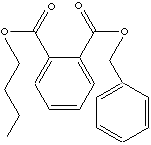|
BUTYL BENZYL PHTHALATE |
||||||||||||||||||||||||||||||||||||||||||||||||||||||||||||||||||||||||||||||||||||||
|
PRODUCT IDENTIFICATION |
||||||||||||||||||||||||||||||||||||||||||||||||||||||||||||||||||||||||||||||||||||||
| CAS NO. |
85-68-7 |
|
||||||||||||||||||||||||||||||||||||||||||||||||||||||||||||||||||||||||||||||||||||
| EINECS NO. | 201-622-7 | |||||||||||||||||||||||||||||||||||||||||||||||||||||||||||||||||||||||||||||||||||||
| FORMULA | 2-[CH3(CH2)3O2C]C6H4CO2CH2C6H5 | |||||||||||||||||||||||||||||||||||||||||||||||||||||||||||||||||||||||||||||||||||||
| MOL WT. | 312.37 | |||||||||||||||||||||||||||||||||||||||||||||||||||||||||||||||||||||||||||||||||||||
| H.S. CODE | 2917.30 | |||||||||||||||||||||||||||||||||||||||||||||||||||||||||||||||||||||||||||||||||||||
|
TOXICITY |
Oral rat LD50: 2330 mg/kg | |||||||||||||||||||||||||||||||||||||||||||||||||||||||||||||||||||||||||||||||||||||
| SYNONYMS | BBP; Phthalic acid, benzyl butyl ester; | |||||||||||||||||||||||||||||||||||||||||||||||||||||||||||||||||||||||||||||||||||||
| 1,2-benzenedicarboxylic acid butyl phenylmethyl ester; benzyl n-butyl phthalate; Benzyl butyl phthalate; Phtalate de butyl benzyle; | ||||||||||||||||||||||||||||||||||||||||||||||||||||||||||||||||||||||||||||||||||||||
| SMILES | ||||||||||||||||||||||||||||||||||||||||||||||||||||||||||||||||||||||||||||||||||||||
|
CLASSIFICATION |
|
|||||||||||||||||||||||||||||||||||||||||||||||||||||||||||||||||||||||||||||||||||||
|
PHYSICAL AND CHEMICAL PROPERTIES |
||||||||||||||||||||||||||||||||||||||||||||||||||||||||||||||||||||||||||||||||||||||
| PHYSICAL STATE | clear, oily liquid | |||||||||||||||||||||||||||||||||||||||||||||||||||||||||||||||||||||||||||||||||||||
| MELTING POINT | -35 C | |||||||||||||||||||||||||||||||||||||||||||||||||||||||||||||||||||||||||||||||||||||
| BOILING POINT | 370 | |||||||||||||||||||||||||||||||||||||||||||||||||||||||||||||||||||||||||||||||||||||
| SPECIFIC GRAVITY | 1.123 | |||||||||||||||||||||||||||||||||||||||||||||||||||||||||||||||||||||||||||||||||||||
| SOLUBILITY IN WATER |
insoluble |
|||||||||||||||||||||||||||||||||||||||||||||||||||||||||||||||||||||||||||||||||||||
|
SOLVENT SOLUBILITY |
Soluble in all common solvents |
|||||||||||||||||||||||||||||||||||||||||||||||||||||||||||||||||||||||||||||||||||||
| pH |
|
|||||||||||||||||||||||||||||||||||||||||||||||||||||||||||||||||||||||||||||||||||||
| VAPOR DENSITY | ||||||||||||||||||||||||||||||||||||||||||||||||||||||||||||||||||||||||||||||||||||||
| HENRY'S LAW |
|
|||||||||||||||||||||||||||||||||||||||||||||||||||||||||||||||||||||||||||||||||||||
| NFPA RATINGS | Health: 1 Flammability: 1 Reactivity: 0 | |||||||||||||||||||||||||||||||||||||||||||||||||||||||||||||||||||||||||||||||||||||
|
REFRACTIVE INDEX |
1.5410 - 1.5420 |
|||||||||||||||||||||||||||||||||||||||||||||||||||||||||||||||||||||||||||||||||||||
| FLASH POINT | 220 C | |||||||||||||||||||||||||||||||||||||||||||||||||||||||||||||||||||||||||||||||||||||
| STABILITY | Stable under ordinary conditions | |||||||||||||||||||||||||||||||||||||||||||||||||||||||||||||||||||||||||||||||||||||
|
GENERAL DESCRIPTION AND APPLICATIONS |
||||||||||||||||||||||||||||||||||||||||||||||||||||||||||||||||||||||||||||||||||||||
Phthalates are by far the most widely used plasticisers, primarily to make soft
and flexible polyvinyl chloride (PVC) for the applications in the industry of
automotive, building & construction material, cable, flooring, medical
device and toys. Phthalates make the long polyvinyl molecules to slide against
one another. Minor quantity of phthalates are used in adhesives, caulk,
sealants, paint to improve work performance. Small molecule phthalates are used
as solvents in perfumes to provide longer linger longer and in nail polish to
prevent chipping. They are also used as ingredients of insect repellents, as
solvents in lacquer and pesticides, and as dye carrier. They are used as textile
lubricating agents and as solid rocket propellents. Phthalates are produced by
the reaction of phthalic anhydride with appropriate alcohols from methanol up to
isodecanol (C13), either as a straight chain or with some branched in the
presence of concentrated sulphuric acid as a catalyst. Excess alcohols are
recovered and recycled and phthalates are purified by vacuum distillation and/or
activated charcoal. A wide range of phthalates of varying chain length and
structure provides each adequate properties and cost-effective for various
processing and mechanical requirements. C8 - C9 phthalates, such as di-2-ethyl
hexyl phthalate (DEHP or called DOP), diisodecyl phthalate (DIDP) and diisononyl
phthalate (DINP) are the most widely used general purpose phthalates. DOP is the
dominant plasticizer used in PVC, providing low cost. Short chain phthalates (C3
- C7) are used when rapid setting and stain resistance is required. 2-Ethyl
hexanol, produced by the dimerisation of butyraldehyde obtained from propylene,
is cheaper than isononyl alcohol which are prepared by the carbonylation of an
olefin. Long chain phthalates (C11 - C13) are used when high temperature
stability is required. C1 and C2 phthalates are used as solvents. Special
phthalates which contain aromatic ring in the side chain are used when
fast-fused is required. Diallyl phthalate is used as a crosslinking agent,
plasticizer or dying carrier for polyesters. Examples of common phthalates
include:
Butyl Benzyl Phthalate is used as a plasticizer for polyvinyl chloride, polyvinyl acetate, rubbers, cellulose plastics and polyurethane. End application include PVC floorings and wall coverings, expanded leather, PVC foams, films, sealing and adhesive systems based on polyurethane or polysulphide, PVAc based adhesives and paint binders. |
||||||||||||||||||||||||||||||||||||||||||||||||||||||||||||||||||||||||||||||||||||||
| SALES SPECIFICATION | ||||||||||||||||||||||||||||||||||||||||||||||||||||||||||||||||||||||||||||||||||||||
|
APPEARANCE |
clear liquid |
|||||||||||||||||||||||||||||||||||||||||||||||||||||||||||||||||||||||||||||||||||||
|
ESTER CONTENT |
99.0% min |
|||||||||||||||||||||||||||||||||||||||||||||||||||||||||||||||||||||||||||||||||||||
|
ACID NUMBER |
0.1 max (mg KOH/g) |
|||||||||||||||||||||||||||||||||||||||||||||||||||||||||||||||||||||||||||||||||||||
| COLOR, HAZEN | 50 max | |||||||||||||||||||||||||||||||||||||||||||||||||||||||||||||||||||||||||||||||||||||
| WATER | 0.1% max | |||||||||||||||||||||||||||||||||||||||||||||||||||||||||||||||||||||||||||||||||||||
|
SAPONIFICATION NO, |
360 ± 5 (mg KOH/g) |
|||||||||||||||||||||||||||||||||||||||||||||||||||||||||||||||||||||||||||||||||||||
| TRANSPORTATION | ||||||||||||||||||||||||||||||||||||||||||||||||||||||||||||||||||||||||||||||||||||||
| PACKING |
225 kg in drum |
|||||||||||||||||||||||||||||||||||||||||||||||||||||||||||||||||||||||||||||||||||||
| HAZARD CLASS |
Not regulated |
|||||||||||||||||||||||||||||||||||||||||||||||||||||||||||||||||||||||||||||||||||||
| UN NO. | ||||||||||||||||||||||||||||||||||||||||||||||||||||||||||||||||||||||||||||||||||||||
| OTHER INFORMATION | ||||||||||||||||||||||||||||||||||||||||||||||||||||||||||||||||||||||||||||||||||||||
|
|
||||||||||||||||||||||||||||||||||||||||||||||||||||||||||||||||||||||||||||||||||||||
